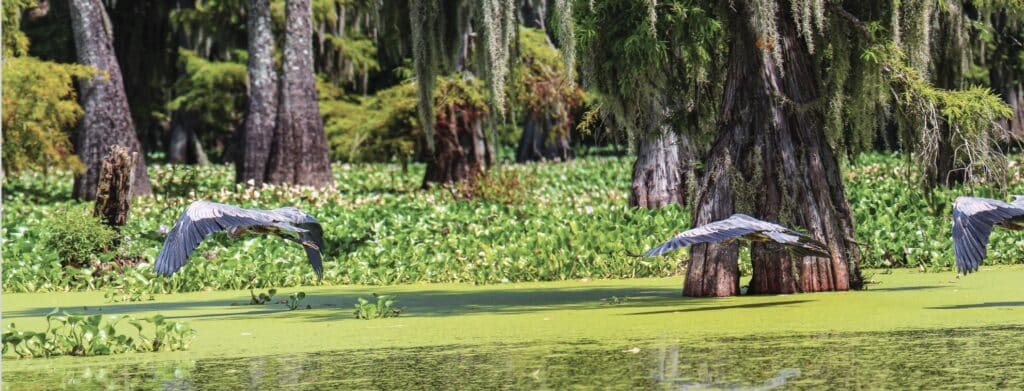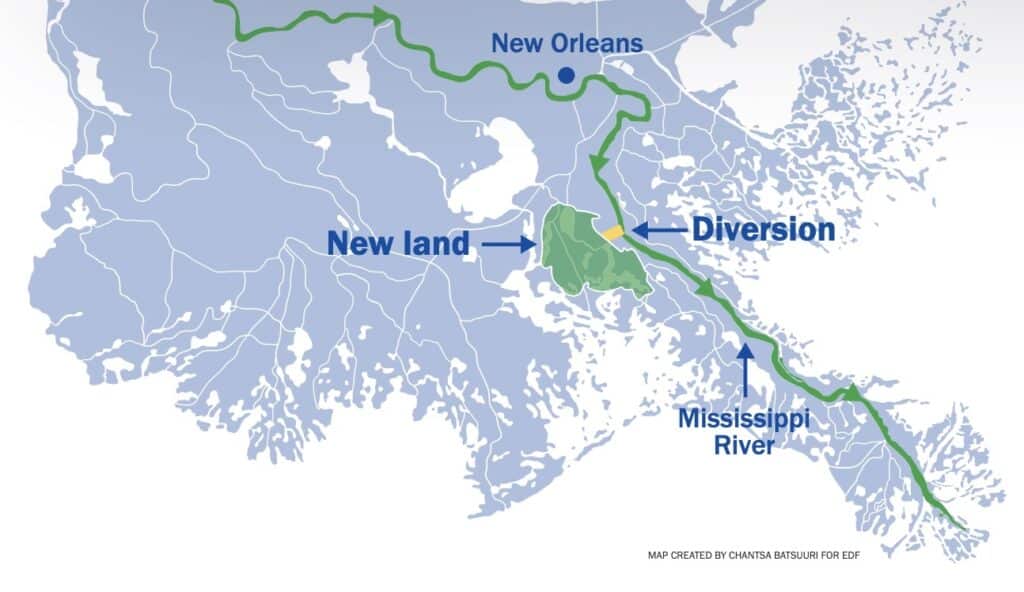The following blog post is a summary of the Saving the Wetlands article by Shenti Menon that appeared in the Environmental Defense Fund’s Volume 55, Number 1 Winter 2024 edition of Solutions magazine.

Photo courtesy of Getty Images
Louisiana’s coastline is a marvel, a dynamic landscape shaped by the mighty Mississippi River, but it’s also one of the fastest-disappearing places on Earth. Over the years, human interventions like levees and dams have disrupted the natural flow of sediment, causing the wetlands that act as a buffer against storms and floods to erode at an alarming rate. Since the 1930s, an area equivalent to the size of Delaware has vanished from Louisiana’s wetlands, leaving communities vulnerable to the increasing threats of climate change. Enter the ambitious project championed by the Environmental Defense Fund (EDF) and partners: the restoration of Louisiana’s coastal wetlands using the power of the Mississippi River itself. This groundbreaking endeavor, part of Louisiana’s $50 billion plan to bolster coastal resilience, seeks to counteract land loss by allowing the river to flow freely and replenish the disappearing wetlands.
The Mississippi River, flowing over 2,000 miles through the heart of America, carries with it rich sediment that has historically nourished Louisiana’s coastal ecosystems. However, human efforts to control the river’s course have disrupted this natural process, leading to the rapid disappearance of land. Levees and other structures built by the U.S. Army Corps of Engineers to manage navigation and flood protection have inadvertently starved the wetlands of sediment, exacerbating the effects of subsidence and sea-level rise.

Represented in yellow, the Mid-Barataria sediment diversion will replenish the dying wetlands.
The Mid-Barataria Sediment Diversion project represents a paradigm shift in how we approach coastal restoration. Instead of fighting against the river’s natural processes, Louisiana is embracing them. Engineers will create a 2-mile-long channel to reconnect the river with the vanishing wetlands of Barataria Bay, allowing sediment-rich water to flow in and rebuild land. This approach mimics the natural diversions that occur when the Mississippi finds weak spots in its banks, carving new paths to the sea and depositing sediment along the way. Already, natural diversions like Neptune Pass in Plaquemines Parish have demonstrated the potential of sediment to create new land. Satellite images show muddy sediment flowing into coastal waters, where it accumulates and forms the foundation for new wetlands. With the Mid-Barataria Sediment Diversion, this process will be accelerated, restoring 20–40 square miles of wetlands over the next 50 years.
But the project isn’t without its challenges and controversies. Some stakeholders, particularly in the fishing industry, are concerned about the potential impact on their livelihoods. The diversion of freshwater into saltwater habitats could disrupt ecosystems and alter the distribution of fish and shellfish. However, proponents argue that the long-term benefits of coastal restoration far outweigh these concerns. By protecting and enhancing the natural environment, the project aims to safeguard not only vulnerable communities but also the rich biodiversity of Louisiana’s coast. Moreover, the project is not just about restoring land; it’s also about supporting the communities that rely on these ecosystems for their survival. Louisiana has allocated significant funds to mitigate the impact of the diversion on fisheries and other industries. Investments in new gear, oyster cultivation, and flood mitigation measures demonstrate a commitment to balancing environmental restoration with economic prosperity.
In addition to large-scale infrastructure projects, innovative initiatives are emerging to address the interconnected challenges of climate change and agriculture. Programs like the Regenerative Agriculture Financing Program, developed by EDF and Farmers Business Network, reward farmers for adopting climate-smart practices that reduce emissions and build soil health. By incentivizing sustainable farming methods, these programs not only mitigate climate change but also improve the resilience of agricultural systems. Louisiana’s coastal restoration efforts serve as a model for proactive adaptation to environmental challenges. By harnessing the power of nature and investing in community resilience, we can protect our precious coastal landscapes for generations to come. The challenges ahead are immense, but with collaboration and innovation, we can ensure a brighter future for Louisiana’s coast and its people.
#CoastalRestoration #MississippiRiver #Wetlands #Sustainability #Community Resilience #EnvironmentalStewardship #Innovation
